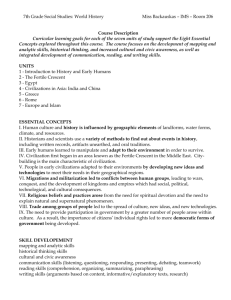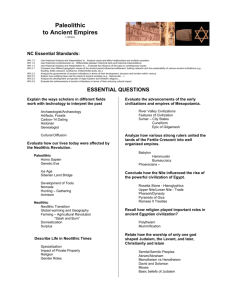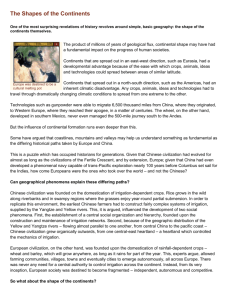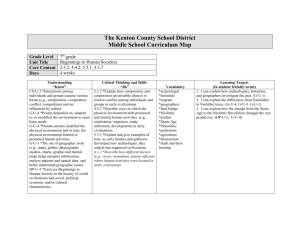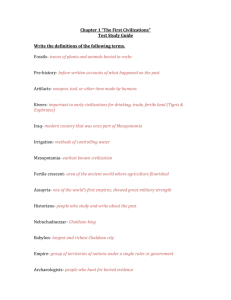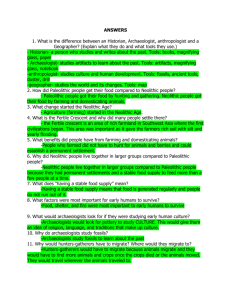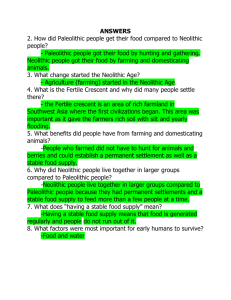Station 1: Continents & Oceans I can identify the seven continents
advertisement
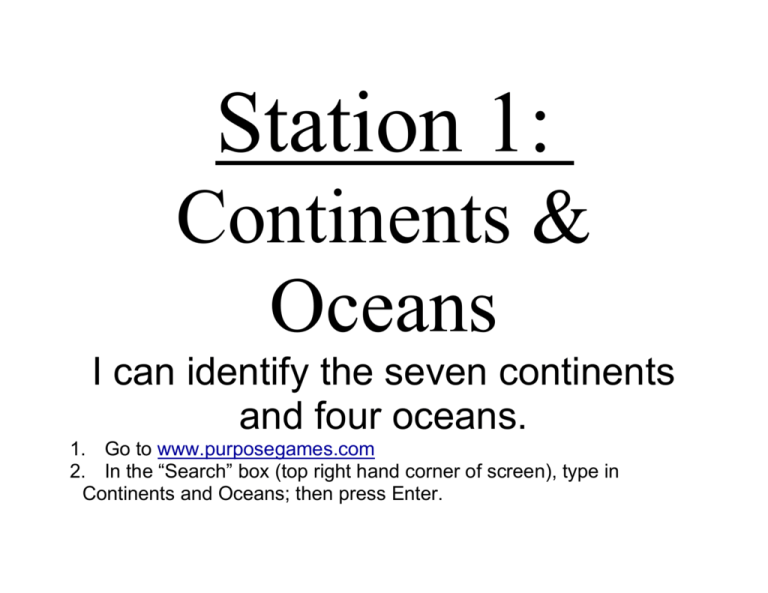
Station 1: Continents & Oceans I can identify the seven continents and four oceans. 1. Go to www.purposegames.com 2. In the “Search” box (top right hand corner of screen), type in Continents and Oceans; then press Enter. 3. Multiple games will appear. You may play and (or all) of these to practice identifying and labeling the seven continents and four oceans. 4. To play one of the games, simply choose one and click on it. A screen will come up with information, comments, and scores on the particular game. To actually play it, though, click on the image (most have a world map) in the top left corner of the screen. 5. Once you click start, the name of a continent or ocean will appear in the box above the Start button. Find that continent or ocean and click on its dot. Once you have clicked on the correct dot, another continent or ocean will appear in the box above the Start button. Repeat this process until you have completed the activity. 6. Once you are finished, you may repeat the same game to better your score and/or time, or you may play a different “Continents and Oceans” game. Station 2: Absolute & Relative Location I can locate locations using longitude and latitude. I can describe the location of places using relative location. Step #1: Of the examples listed, identify which ones are relative location. Simply write the letter of the example on your paper, you do not have to write the entire statement. a. Kentucky is north of Tennessee. b. Turn left by the grocery store. c. 38ºN, 130ºE d. Bowling Green is west of Glasgow. e. 202 Pintail Drive, Bowling Green, KY f. St. Petersburg lies on the coast of the Baltic Sea, at 60ºN, 30ºE. g. Kansas City, Missouri is just east of Kansas City, Kansas. h. The Great Barrier Reef is by Australia. i. The capital of Malaysia is 3ºN, 101E. j. Oklahoma is in the harvest belt. k. Egypt is in Africa. l. Africa is in the Eastern Hemisphere. m. Colorado is west of Missouri. Step #2: Use the map of the world to find the coordinates of the locations listed on your paper. Station 3: Maps I can identify key features of a map. I can compare various types of maps. Step #1: Identify the parts of the map. Write your answers on your own paper. Step #2: Look at the maps at this station. Determine if each is a political map (POL), a physical map (PHYS), or a special purpose (SP) map. You may simply write the abbreviations for each on your paper. Station 4: 5 Themes of Geography I can explain the five themes of Geography. I can apply the five themes of Geography. Step #1: Identify the five themes of Geography. Explain each. Write your answer on your paper. Step #2: Look at the worksheet titled, “Applying the Five Themes of Geography.” Answer ONLY the questions that are listed on your paper. Station 5: Paleolithic vs. Neolithic I can compare the Paleolithic and the Neolithic Ages. I can examine the culture of prehistory. I can analyze the impact of technology in the prehistoric periods. I can survey the impact of domestication on the establishment of communities in the Neolithic Age. Step #1: Identify which statements refer to the Paleolithic Age and which statements refer to the Neolithic Age. Simply write the number of the statement in the correct column on your paper. 1. 2. 3. 4. Humans gathered food by hunting and gathering. The time period from 10,000 BCE onward The time period from roughly 2 million BCE to 10,000 BCE Most tools and weapons were made of stone. 5. Communities had a more stable food supply. 6. People began to live in more permanent settlements/civilizations. 7. Art was basic, consisting mainly of cave paintings. 8. Art was more elaborate and advanced, consisting of decorated clay and figurines. 9. Clothing was made of cloth. 10. Clothing was made of animal skins. 11. People believed that there was life after death, which caused the deceased to be buried with things, such as food and tools, that they would need in their life after death. 12. Elaborate structures were built for worship. 13. People were nomads, meaning they moved around as their food supply moved. People developed ways to measure seeds, ways to keep track of time, and ways to use animals for farming and work. 14. People lived in caves or tent-like huts made from animal skins. 16. Men served as leaders of their groups/tribes/communities. Step #2: How did “technology” affect BOTH prehistoric periods? Keep in mind, technology an be anything that makes a task easier. Write your answer on your paper. Step #3: How did domestication impact civilizations in the Neolithic Age? How did specialization impact civilizations in the Neolithic Age? Write your answer on your paper. Station 6: Timelines I can interpret a timeline. Answer the following questions on your paper: Step #1: Look at timeline #1. What do the “lightening bolts” represent and why are they used on this particular timeline? Step #2: Look at timeline #2. In what year will this student graduate? Step #3: Look at timeline #3. What is the difference in time (in years) between this student’s visit to New York and his participation in the University of Kentucky’s basketball camp? Step #4: What is the age difference (in years) between this student and her brother, Alex? Station 7: The Fertile Crescent I can analyze the relationship between geography and the development of city-states. I can assess why the first civilizations began in the Fertile Crescent. I can locate the Fertile Crescent. Step #1: Use the map provided to locate the Fertile Crescent. On your paper, explain where the Fertile Crescent is using relative location. Step #2: What is the relationship between geography and the development of city-states? Why does this relationship exist? Why did some of the world’s first civilizations begin in the Fertile Crescent? Write your answers on your paper. Station 8: Empires I can justify the importance of Hammurabi’s Code. I can analyze the effect of empires in the Fertile Crescent. Step #1: Think about Sargon and the Akkadians and Hammurabi building their empires, how long these empires lasted, and the contributions of these empires. What effect did these empires have in the Fertile Crescent? What effect did these empires have on us today? Write your answer on your paper. Step #2: Justify the importance of Hammurabi’s Code. Write your answer on your paper. Station 9: Sumerian Contributions I can interpret the Sumerians’ contributions to society. Step #1: List as many Sumerian contributions on your paper as you can. You may work with others at this station to compile a list. Write your list on your paper. Station 10: For Fun! Step #1: Write the word that matches each clue on your paper. Looking at the worksheet, what would be the word created by the shaded boxes? For that word, also write the definition. Step #2: Look at the letters below. Use the clues to unscramble the letters. Write the answers on your paper.
